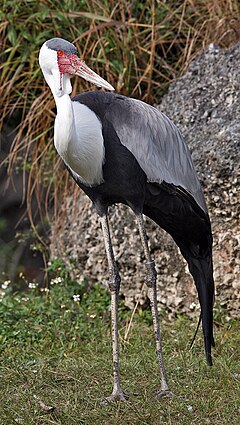Bugeranus
| Wattled crane | |
|---|---|
 |
|
| Scientific classification | |
| Kingdom: | Animalia |
| Phylum: | Chordata |
| Class: | Aves |
| Order: | Gruiformes |
| Family: | Gruidae |
| Genus: | Grus |
| Species: | G. carunculata |
| Binomial name | |
|
Grus carunculata (Gmelin, 1789) |
|
| Synonyms | |
|
|
The wattled crane (Grus carunculata) is a large bird found in Africa, south of the Sahara Desert. It is sometimes placed in the monotypic genus Bugeranus.
The first formal description of the wattled crane was by the German naturalist Johann Friedrich Gmelin in 1789 under the binomial name Ardea carunculata. Gmelin based his account on the "wattled heron" that had been described and illustrated by the English ornithologist John Latham in 1785. The specific epithet is from the Latin caruncula meaning "a small piece of flesh".
The wattled crane was formerly placed in its own genus Bugeranus. A molecular phylogenetic study published in 2010 found that the genus Grus within the crane family was not monophyletic and that the wattled crane was a sister species to a clade containing the blue crane and the demoiselle crane. In the resulting reorganization of the genera, the wattled crane was moved to the genus Grus. Some taxonomists retain the wattled crane within Bugeranus. The wattled crane is monotypic: there are no recognised subspecies.
At a height of up to 175 cm (5.74 ft), it is the largest crane in Africa and is the second tallest species of crane, after the sarus crane. The wingspan is 230–260 cm (7.5–8.5 ft), the length is typically 120 cm (3.9 ft) and weight is 6.4–7.9 kg (14–17 lb) in females, 7.5–9 kg (17–20 lb) in males. Among standard measurements, the wing chord length is 61.3–71.7 cm (24.1–28.2 in), the exposed culmen is 12.4–18.5 cm (4.9–7.3 in) and the tarsus is 23.2–34.2 cm (9.1–13.5 in). The back and wings are ashy gray. The feathered portion of the head is dark slate gray above the eyes and on the crown, but is otherwise white, including the wattles, which are almost fully feathered and hang down from under the upper throat. The breast, primaries, secondaries, and tail coverts are black. The secondaries are long and nearly reach the ground. The upper breast and neck are white all the way to the face. The skin in front of the eye extending to the base of the beak and tip of the wattles is red and bare of feathers and covered by small round wart-like bumps. Wattled cranes have long bills and black legs and toes. Males and females are virtually indistinguishable, although males tend to be slightly larger.
...
Wikipedia

